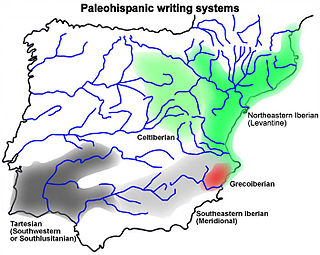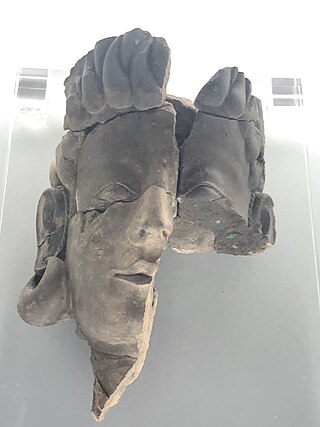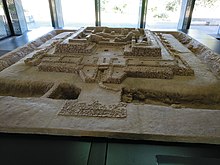
Tartessos is, as defined by archaeological discoveries, a historical civilization settled in the southern Iberian Peninsula characterized by its mixture of local Paleohispanic and Phoenician traits. It had a writing system, identified as Tartessian, that includes some 97 inscriptions in a Tartessian language.

Huelva is a municipality of Spain and the capital of the province of Huelva, in the autonomous community of Andalusia. Located in the soutwest of the Iberian Peninsula, it sits between the estuaries of the Odiel and Tinto rivers on the Atlantic coast of the Gulf of Cádiz. According to the 2010 census, the city had a population of 149,410.
The falcata is a type of sword typical of pre-Roman Iberia. The falcata was used to great effect for warfare in the ancient Iberian peninsula, and is firmly associated with the southern Iberian tribes, among other ancient peoples of Hispania. It was highly prized by the ancient general Hannibal, who equipped Carthaginian troops with it during the Second Punic War.

Tartessian is an extinct Paleo-Hispanic language found in the Southwestern inscriptions of the Iberian Peninsula, mainly located in the south of Portugal, and the southwest of Spain. There are 95 such inscriptions, the longest having 82 readable signs. Around one third of them were found in Early Iron Age necropolises or other Iron Age burial sites associated with rich complex burials. It is usual to date them to the 7th century BC and to consider the southwestern script to be the most ancient Paleo-Hispanic script, with characters most closely resembling specific Phoenician letter forms found in inscriptions dated to c. 825 BC. Five of the inscriptions occur on stelae that have been interpreted as Late Bronze Age carved warrior gear from the Urnfield culture.

The Southwest Script or Southwestern Script, also known as Tartessian, South Lusitanian and Conii script is a Paleohispanic script used to write an unknown language usually identified as Tartessian. Southwest inscriptions have been found mainly in the southwestern quadrant of the Iberian Peninsula, mostly in the south of Portugal, but also in Spain.
Zalamea de la Serena is a municipality in the province of Badajoz, Extremadura, Spain. According to the 2014 census, the municipality has a population of 3797 inhabitants.

The southeastern Iberian script, also known as Meridional Iberian, was one of the means of written expression of the Iberian language, which was written mainly in the northeastern Iberian script and residually by the Greco-Iberian alphabet. About the relation between northeastern Iberian and southeastern Iberian scripts, it is necessary to point out that they are two different scripts with different values for the same signs; however it is clear that they had a common origin and the most accepted hypothesis is that northeastern Iberian script derives from southeastern Iberian script. In fact, the southeastern Iberian script is very similar, both considering the shape of the signs or their values, to the Southwestern script used to represent an unknown language usually named Tartessian. The main difference is that southeastern Iberian script does not show the vocalic redundancy of the syllabic signs. Unlike the northeastern Iberian script the decipherment of the southeastern Iberian script is not yet complete, because there are a significant number of signs on which scholars have not yet reached a consensus. Although it is believed that the southeastern Iberian script does not show any system to differentiate between voiced and unvoiced occlusives, unlike the northeastern Iberian script, a recent paper defends the existence of a dual system also in the southeastern Iberian script.

The Espanca script is the first signary known of the Paleohispanic scripts. It is inscribed on a piece of slate, 48×28×2 cm. This alphabet consists of 27 letters written double. The 27 letters in the outer line are written in a better hand than those of the inner line, from which it has been inferred that the slate was a teaching exercise in which a master wrote the alphabet and a student copied it.
Bandua was a theonym used to refer to a god or goddess worshipped in Iberia by Gallaeci and Lusitanians. Whether the name referred to a discrete deity or was an epithet applied to different deities is arguable.
The economy of Hispania, or Roman Iberia, experienced a strong revolution during and after the conquest of the peninsular territory by Rome, in such a way that, from an unknown but promising land, it came to be one of the most valuable acquisitions of both the Republic and Empire and a basic pillar that sustained the rise of Rome.
Reo is a name appearing on Latin dedications to a Lusitanian-Gallaecian deity, usually with an epithet relating to a place, such as Reo Paramaeco discovered in Lugo in Galicia. The name Reo is in the Latin dative case, for a Latinized name *Reus.

Martín Almagro Gorbea is a Spanish prehistorian.

The Treasure of El Carambolo was found in El Carambolo hill in the municipality of Camas, 3 kilometers west of Seville, on 30 September 1958. The discovery of the treasure hoard spurred interest in the Tartessos culture, which prospered from the 9th to the 6th centuries BCE, but recent scholars have debated whether the treasure was a product of local culture or of the Phoenicians. The treasure was found by Spanish construction workers during renovations being made at a pigeon shooting society.

Anna Pujol Puigvehí. Historian, professor and archaeologist. Bachelor of Arts from the University of Barcelona (1970), with the thesis “The Indiketes as the literary and archaeological sources”, Dr. summa cum laude in History from the Autonomous University of Barcelona with the doctoral thesis on the “Pre-Roman Population of the Northeast of the Iberian Peninsula. Genesis and development of Iberian culture in the Girona and south of France lands” (1981). She has taught at the Autonomous University of Barcelona for over 15 years, and has been Associate professor of Archaeology and Ancient History of the UOC. She won a Chair of Professor of History of Secondary Schools in 1981.
The Suessetani were a pre-Roman people of the northeast Iberian Peninsula that dwelt mainly in the plains area of the Alba (Arba) river basin, in today's Cinco Villas, Aragon, Zaragoza Province and Bardenas Reales area, west of the Gallicus river, east of the low course of the Aragon river and north of the Iberus (Ebro) river, in the valley plains of this same river. Their location, in relation to other tribes, was south of the Iacetani, west of the Vescetani or Oscenses north of the Lusones and Pellendones, also north of the Sedetani, and southeast of the Vascones.

The history of ancient Iberian coinage begins as early as the fifth century BC, but widespread minting and circulation in the Iberian peninsula did not begin until late in the third century, during the Second Punic War. Civic coinages - emissions made by individual cities at their own volition - continued under the first two and a half centuries of Roman control until ending in the mid-first century AD. Some non-civic coins were minted on behalf of Roman emperors during this period and continued to be minted after the cessation of the civic coinages. After the cessation of the civic coinages, these Imperial coins were the only coins minted in Iberia until the coins of the Suebi and Visigoths.

The Provincial Archaeological Museum of Badajoz or simply the Archaeological Museum of Badajoz is an archaeology museum located in Badajoz, Spain. Owned by the Spanish State, its management has been transferred to the Junta of Extremadura.

Human sacrifice in the ancient Iberian Peninsula is recorded in classical sources, which give it as a custom of Lusitanians and other Celtic peoples from the northern area of the peninsula. Its most complete mention comes from the work of Greek chronicler Strabo, in which those ceremonies have a divinatory utility. Modern authors have seen in this phenomenon hints of a possible priestly class among the mentioned peoples, similar to but differentiated from European Celtic druids.
Blanca María Prósper Pérez is a Spanish linguist and scholar of Celtic studies. Since 2019, she has been Professor (Catedrática) in Indo-European linguistics at the University of Salamanca.

El Turuñuelo, also called Casas del Turuñuelo and El Turuñuelo de Guareña, is an archaeological site in Guareña, province of Badajoz, Spain. It corresponds to the late Tartessian culture developed in the Middle Guadiana Valley in the southwestern Iberian Peninsula in the 5th century BCE after the downfall of the Tartessian archaeological culture's main core around the Guadalquivir valley by the end of the 6th century BCE. It consists of a big building which was ritually set on fire and buried after a hecatomb-like ceremony was performed.












